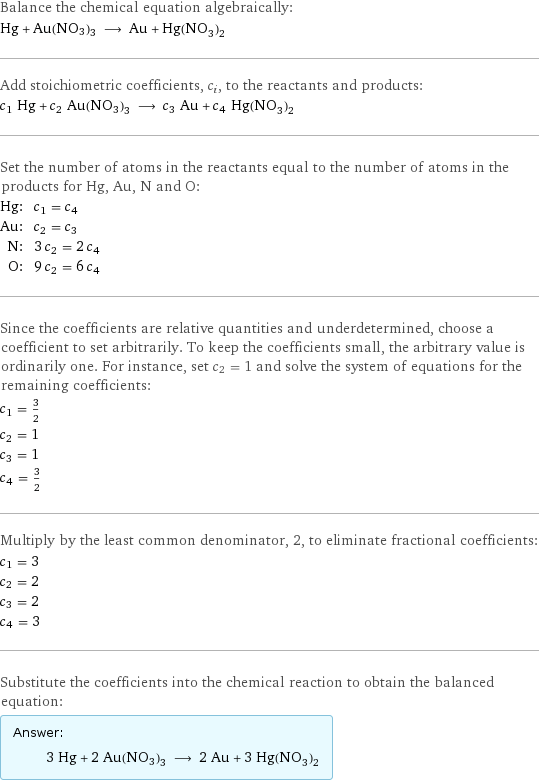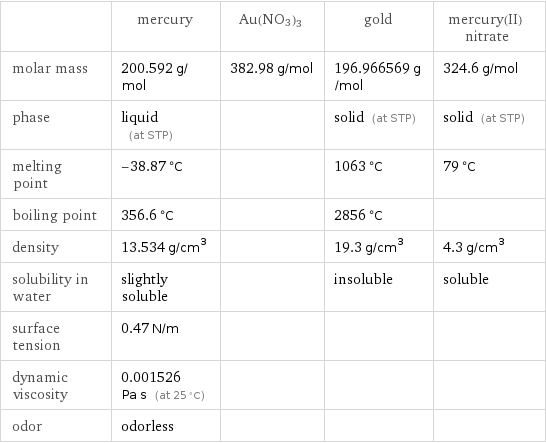Input interpretation

Hg mercury + Au(NO3)3 ⟶ Au gold + Hg(NO_3)_2 mercury(II) nitrate
Balanced equation

Balance the chemical equation algebraically: Hg + Au(NO3)3 ⟶ Au + Hg(NO_3)_2 Add stoichiometric coefficients, c_i, to the reactants and products: c_1 Hg + c_2 Au(NO3)3 ⟶ c_3 Au + c_4 Hg(NO_3)_2 Set the number of atoms in the reactants equal to the number of atoms in the products for Hg, Au, N and O: Hg: | c_1 = c_4 Au: | c_2 = c_3 N: | 3 c_2 = 2 c_4 O: | 9 c_2 = 6 c_4 Since the coefficients are relative quantities and underdetermined, choose a coefficient to set arbitrarily. To keep the coefficients small, the arbitrary value is ordinarily one. For instance, set c_2 = 1 and solve the system of equations for the remaining coefficients: c_1 = 3/2 c_2 = 1 c_3 = 1 c_4 = 3/2 Multiply by the least common denominator, 2, to eliminate fractional coefficients: c_1 = 3 c_2 = 2 c_3 = 2 c_4 = 3 Substitute the coefficients into the chemical reaction to obtain the balanced equation: Answer: | | 3 Hg + 2 Au(NO3)3 ⟶ 2 Au + 3 Hg(NO_3)_2
Structures

+ Au(NO3)3 ⟶ +
Names

mercury + Au(NO3)3 ⟶ gold + mercury(II) nitrate
Equilibrium constant
![Construct the equilibrium constant, K, expression for: Hg + Au(NO3)3 ⟶ Au + Hg(NO_3)_2 Plan: • Balance the chemical equation. • Determine the stoichiometric numbers. • Assemble the activity expression for each chemical species. • Use the activity expressions to build the equilibrium constant expression. Write the balanced chemical equation: 3 Hg + 2 Au(NO3)3 ⟶ 2 Au + 3 Hg(NO_3)_2 Assign stoichiometric numbers, ν_i, using the stoichiometric coefficients, c_i, from the balanced chemical equation in the following manner: ν_i = -c_i for reactants and ν_i = c_i for products: chemical species | c_i | ν_i Hg | 3 | -3 Au(NO3)3 | 2 | -2 Au | 2 | 2 Hg(NO_3)_2 | 3 | 3 Assemble the activity expressions accounting for the state of matter and ν_i: chemical species | c_i | ν_i | activity expression Hg | 3 | -3 | ([Hg])^(-3) Au(NO3)3 | 2 | -2 | ([Au(NO3)3])^(-2) Au | 2 | 2 | ([Au])^2 Hg(NO_3)_2 | 3 | 3 | ([Hg(NO3)2])^3 The equilibrium constant symbol in the concentration basis is: K_c Mulitply the activity expressions to arrive at the K_c expression: Answer: | | K_c = ([Hg])^(-3) ([Au(NO3)3])^(-2) ([Au])^2 ([Hg(NO3)2])^3 = (([Au])^2 ([Hg(NO3)2])^3)/(([Hg])^3 ([Au(NO3)3])^2)](../image_source/cc69da7d113bf24adfb978af4dc36837.png)
Construct the equilibrium constant, K, expression for: Hg + Au(NO3)3 ⟶ Au + Hg(NO_3)_2 Plan: • Balance the chemical equation. • Determine the stoichiometric numbers. • Assemble the activity expression for each chemical species. • Use the activity expressions to build the equilibrium constant expression. Write the balanced chemical equation: 3 Hg + 2 Au(NO3)3 ⟶ 2 Au + 3 Hg(NO_3)_2 Assign stoichiometric numbers, ν_i, using the stoichiometric coefficients, c_i, from the balanced chemical equation in the following manner: ν_i = -c_i for reactants and ν_i = c_i for products: chemical species | c_i | ν_i Hg | 3 | -3 Au(NO3)3 | 2 | -2 Au | 2 | 2 Hg(NO_3)_2 | 3 | 3 Assemble the activity expressions accounting for the state of matter and ν_i: chemical species | c_i | ν_i | activity expression Hg | 3 | -3 | ([Hg])^(-3) Au(NO3)3 | 2 | -2 | ([Au(NO3)3])^(-2) Au | 2 | 2 | ([Au])^2 Hg(NO_3)_2 | 3 | 3 | ([Hg(NO3)2])^3 The equilibrium constant symbol in the concentration basis is: K_c Mulitply the activity expressions to arrive at the K_c expression: Answer: | | K_c = ([Hg])^(-3) ([Au(NO3)3])^(-2) ([Au])^2 ([Hg(NO3)2])^3 = (([Au])^2 ([Hg(NO3)2])^3)/(([Hg])^3 ([Au(NO3)3])^2)
Rate of reaction
![Construct the rate of reaction expression for: Hg + Au(NO3)3 ⟶ Au + Hg(NO_3)_2 Plan: • Balance the chemical equation. • Determine the stoichiometric numbers. • Assemble the rate term for each chemical species. • Write the rate of reaction expression. Write the balanced chemical equation: 3 Hg + 2 Au(NO3)3 ⟶ 2 Au + 3 Hg(NO_3)_2 Assign stoichiometric numbers, ν_i, using the stoichiometric coefficients, c_i, from the balanced chemical equation in the following manner: ν_i = -c_i for reactants and ν_i = c_i for products: chemical species | c_i | ν_i Hg | 3 | -3 Au(NO3)3 | 2 | -2 Au | 2 | 2 Hg(NO_3)_2 | 3 | 3 The rate term for each chemical species, B_i, is 1/ν_i(Δ[B_i])/(Δt) where [B_i] is the amount concentration and t is time: chemical species | c_i | ν_i | rate term Hg | 3 | -3 | -1/3 (Δ[Hg])/(Δt) Au(NO3)3 | 2 | -2 | -1/2 (Δ[Au(NO3)3])/(Δt) Au | 2 | 2 | 1/2 (Δ[Au])/(Δt) Hg(NO_3)_2 | 3 | 3 | 1/3 (Δ[Hg(NO3)2])/(Δt) (for infinitesimal rate of change, replace Δ with d) Set the rate terms equal to each other to arrive at the rate expression: Answer: | | rate = -1/3 (Δ[Hg])/(Δt) = -1/2 (Δ[Au(NO3)3])/(Δt) = 1/2 (Δ[Au])/(Δt) = 1/3 (Δ[Hg(NO3)2])/(Δt) (assuming constant volume and no accumulation of intermediates or side products)](../image_source/4b9d74d21f4c21e1a7c13fb176b19f3d.png)
Construct the rate of reaction expression for: Hg + Au(NO3)3 ⟶ Au + Hg(NO_3)_2 Plan: • Balance the chemical equation. • Determine the stoichiometric numbers. • Assemble the rate term for each chemical species. • Write the rate of reaction expression. Write the balanced chemical equation: 3 Hg + 2 Au(NO3)3 ⟶ 2 Au + 3 Hg(NO_3)_2 Assign stoichiometric numbers, ν_i, using the stoichiometric coefficients, c_i, from the balanced chemical equation in the following manner: ν_i = -c_i for reactants and ν_i = c_i for products: chemical species | c_i | ν_i Hg | 3 | -3 Au(NO3)3 | 2 | -2 Au | 2 | 2 Hg(NO_3)_2 | 3 | 3 The rate term for each chemical species, B_i, is 1/ν_i(Δ[B_i])/(Δt) where [B_i] is the amount concentration and t is time: chemical species | c_i | ν_i | rate term Hg | 3 | -3 | -1/3 (Δ[Hg])/(Δt) Au(NO3)3 | 2 | -2 | -1/2 (Δ[Au(NO3)3])/(Δt) Au | 2 | 2 | 1/2 (Δ[Au])/(Δt) Hg(NO_3)_2 | 3 | 3 | 1/3 (Δ[Hg(NO3)2])/(Δt) (for infinitesimal rate of change, replace Δ with d) Set the rate terms equal to each other to arrive at the rate expression: Answer: | | rate = -1/3 (Δ[Hg])/(Δt) = -1/2 (Δ[Au(NO3)3])/(Δt) = 1/2 (Δ[Au])/(Δt) = 1/3 (Δ[Hg(NO3)2])/(Δt) (assuming constant volume and no accumulation of intermediates or side products)
Chemical names and formulas

| mercury | Au(NO3)3 | gold | mercury(II) nitrate formula | Hg | Au(NO3)3 | Au | Hg(NO_3)_2 Hill formula | Hg | AuN3O9 | Au | HgN_2O_6 name | mercury | | gold | mercury(II) nitrate IUPAC name | mercury | | gold | mercury(+2) cation dinitrate
Substance properties

| mercury | Au(NO3)3 | gold | mercury(II) nitrate molar mass | 200.592 g/mol | 382.98 g/mol | 196.966569 g/mol | 324.6 g/mol phase | liquid (at STP) | | solid (at STP) | solid (at STP) melting point | -38.87 °C | | 1063 °C | 79 °C boiling point | 356.6 °C | | 2856 °C | density | 13.534 g/cm^3 | | 19.3 g/cm^3 | 4.3 g/cm^3 solubility in water | slightly soluble | | insoluble | soluble surface tension | 0.47 N/m | | | dynamic viscosity | 0.001526 Pa s (at 25 °C) | | | odor | odorless | | |
Units
